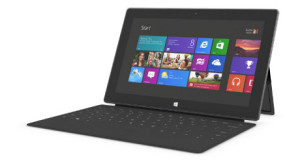
Last week Microsoft had refurbished Surface RT 32G models with Touch Keyboard for $199 shipped. I had to get one, even though I have zero need for one, as the price was too good to pass up. I should have listened to all the negative reviews, but I am a gadget junky and need help.
Now don’t get me wrong, the hardware is pretty well thought out. Nice clear touch screen, stereo sound, USB/HDMI/SDXC ports, wi-fi/bluetooth, and a keyboard that doesn’t need separate power. The down side here is the OS, and even more so the lack of developer support.
This is marketed as a 32gig device, but there is really only about 13gig free as the OS takes the rest. Luckily ARM applications are small and getting additional storage for media via USB/SD isn’t a problem. Still, I am not sure how Microsoft gets away .. oh right, answered my own question there.
Unlike many reviews, the Tegra 3 processor does not feel sluggish to me. Most of the apps load fast, which leads me to believe the few that do not are slow because of sloppy programming. It is also unfortunate Windows RT does not take full advantage of the chipset, unlike its Android counterparts, or there would be better graphic capabilities.
The big problem? The only good programs for the RT platform are those which come pre-installed. Ok, there might be a half dozen apps I loaded from the store that work well, but everything else is junk that looks thrown together. Even worse, the only programs you can install have to come from the store … well at least without some clever hack.
I am curious to see how the release of Windows 8.1 next month improves the tablet. MS Exchange support will be a nice addition to the existing Word/Excel/PowerPoint suite. Better customization of widgets and the return of a “start” button should help too. Unfortunately, I also read the clever hack might be blocked.
I am going to try and use this at work until then, but unless Microsoft can get people to write more applications, my Nexus 7 has no fear of being replaced.